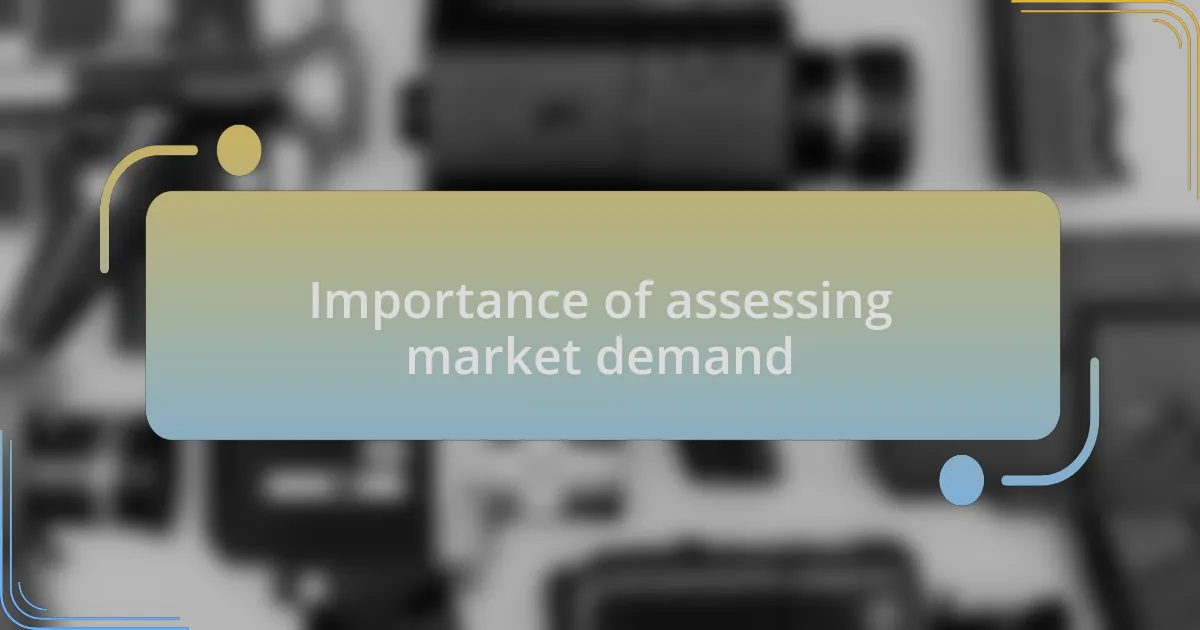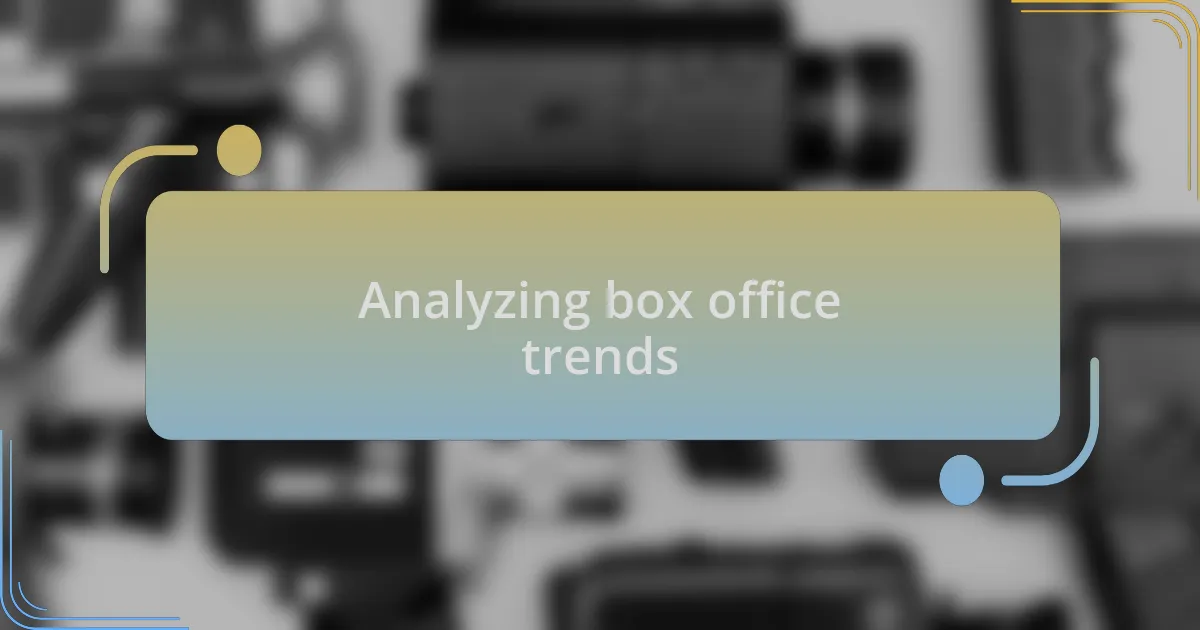Key takeaways:
- Understanding market demand in films involves assessing both data and emotional connections with audiences, particularly regarding nostalgic content.
- Market demand analysis informs creative decisions, minimizes risk, and can determine a film’s success based on audience sentiment rather than just numerical data.
- Qualitative methods such as focus groups and social media analysis are essential for gathering insights into audience preferences and emotional connections.
- Evaluating audience feedback at film festivals provides valuable insights, influenced by context and the reactions of both viewers and industry professionals.

Understanding market demand in films
Understanding market demand in films requires not just data, but also an intuitive grasp of audience desires. I remember sitting in a crowded theater, feeling the palpable excitement for a blockbuster release. This experience made me realize that demand often stems from a collective anticipation built by effective marketing, previous successes, and even cultural narratives.
When assessing market demand, I often find myself considering what makes certain films resonate deeply. For instance, take a look at the recent trend of nostalgia-driven content. Why do audiences flock to remakes of their childhood favorites? I believe it taps into a universal yearning for comfort and familiarity, reflecting how we often turn to films that echo our shared cultural experiences.
It’s fascinating how analytics play a role in this understanding, yet I find that they can only reveal so much. Have you ever wondered if numbers alone tell the whole story? I think they often miss the emotional connections that viewers forge with films. These connections should be at the heart of any demand assessment, as they drive not just ticket sales, but the lasting impact of films on our lives.

Importance of assessing market demand
Assessing market demand is crucial for film production, as it drives project decisions and budgeting. I recall a time when a producer friend of mine hesitated to greenlight a unique script because of perceived market uncertainty. When they finally reviewed audience trends and preferences, it became evident that there was a genuine hunger for original stories—showing how understanding demand can change the trajectory of a project.
Understanding market demand isn’t just about gauging current trends; it’s about anticipating future shifts. I remember discussing with colleagues how platforms like social media foster dialogue around upcoming films. It’s a dynamic environment where what resonates today can shape tomorrow’s blockbusters. This proactive approach can mean the difference between a film that becomes a cultural phenomenon and one that gets lost in obscurity.
Ultimately, the importance of assessing market demand lies in its ability to inform creative choices while minimizing risk. Have you ever considered how a film’s box office performance reflects audience sentiment? I’ve seen films heavily marketed based on strong data fail because they didn’t connect emotionally. Thus, understanding the audience’s heart is as vital as analyzing their viewing habits.

Techniques for gathering audience insights
To gather audience insights effectively, I find qualitative methods, like focus groups, to be invaluable. During one project, I facilitated a discussion with a diverse group of filmgoers about their preferences. Their candid feedback not only revealed unexpected desires for certain genres but also highlighted emotional connections to specific themes. It was an eye-opening experience that reinforced the importance of direct interaction with the audience.
Another technique I often utilize is social media analysis. Tracking hashtags and comments around a film can uncover insights about what audiences are genuinely passionate about. I recall analyzing engagement for a horror film’s trailer release; the comments provided a wealth of information on what scared viewers and what didn’t resonate. Have you tried this? It’s fascinating how a simple scroll can transform your understanding of market demand.
Surveys also play a crucial role in the insights gathering process. I once conducted a survey targeting young adults for a romantic comedy concept. The results revealed not just what they liked, but also their viewing habits and how they preferred accessing content. It’s these patterns that can be the game changer when deciding on the direction of a film project.

Analyzing box office trends
When I analyze box office trends, one of the first things I do is look at opening weekend figures. I remember the buzz surrounding the release of a superhero film that grossed an unexpected amount, which prompted me to dive deeper into its marketing strategies. Was it really just the star power, or was there something in the audience’s anticipation that fueled those numbers? This deep dive not only helped me to understand the success of that specific film but also informed my future projects’ promotional tactics.
Beyond just the numbers, I pay attention to the decline or increase in ticket sales over the weeks following the release. For instance, a dramatic drop in box office revenue often indicates a disconnect between the film’s hype and its actual reception. I once witnessed a comedy that started strong, but daily earnings plummeted after its first week. It made me wonder, was the humor not relatable enough, or were audiences simply looking for something fresh? These insights challenge me to think about how taste can shift rapidly in today’s entertainment landscape.
Lastly, I often compare box office trends of similar genres or franchises. When the latest thriller topped charts consistently, I explored what elements resonated most with viewers. I recall researching audience reactions and noticing a pattern: darker themes coupled with intricate plot twists captivated audiences. It made me think—are we moving toward a broader acceptance of more complex narratives? Understanding these trends can provide invaluable direction when developing new projects.

Evaluating feedback from film festivals
When evaluating feedback from film festivals, I often find that the audience’s reactions can be incredibly telling. I remember screening a dramatic short film at a regional festival; the nuanced reactions during key moments revealed what resonated most with viewers. Did they connect with the emotional arc? Observing their responses allowed me to see which parts truly engaged them and which fell flat.
I also pay close attention to the critiques from industry professionals at these festivals. Feedback from seasoned filmmakers can be both enlightening and daunting. For example, after a screening, a well-respected director pointed out a pacing issue in one of my films. Initially, I felt defensive, but upon reflection, I understood that constructive criticism is essential. It pushed me to rethink my editing choices, ultimately enhancing my storytelling.
Furthermore, the atmosphere at film festivals can influence the feedback I receive. I recall a time when my film screened right after a highly anticipated blockbuster. Audiences seemed initially tired, and I wondered, did my film even stand a chance? The contrast in mood highlighted the importance of timing and event context. It made me realize that understanding the festival’s environment plays a crucial role in interpreting feedback—it’s not just about the film itself, but how it fits into the larger cinematic conversation.